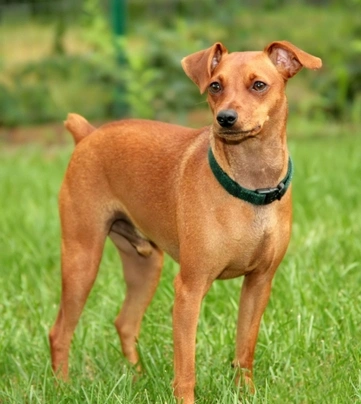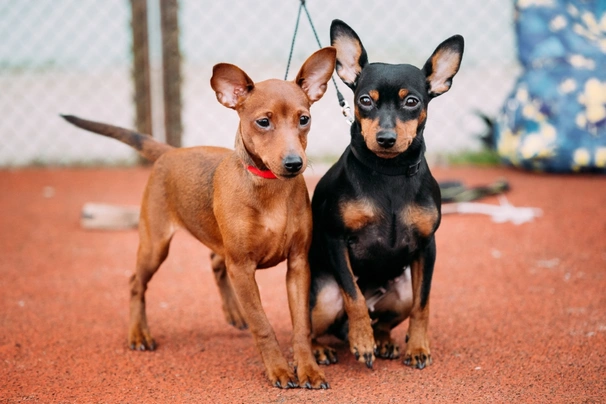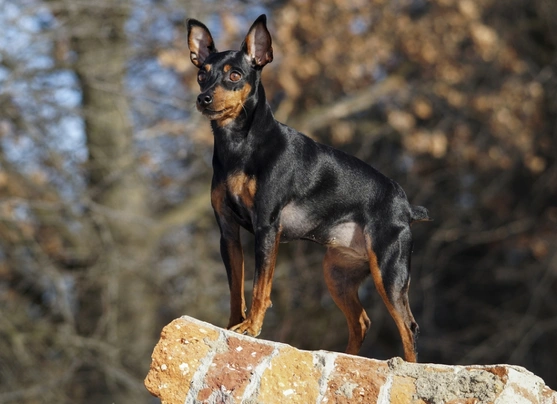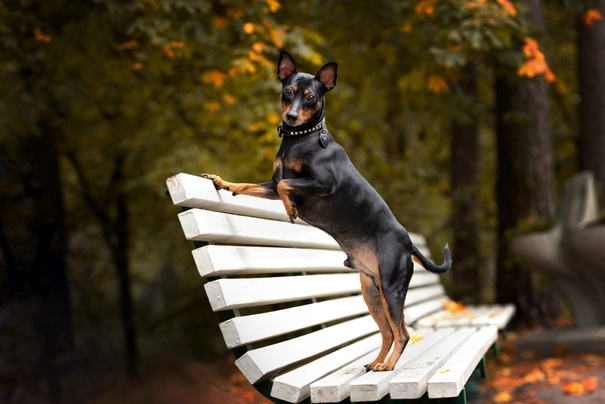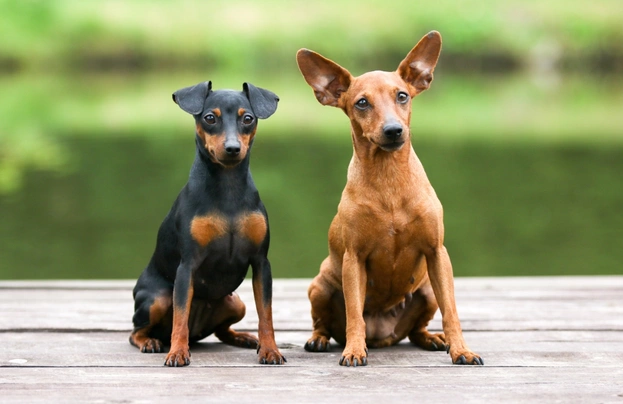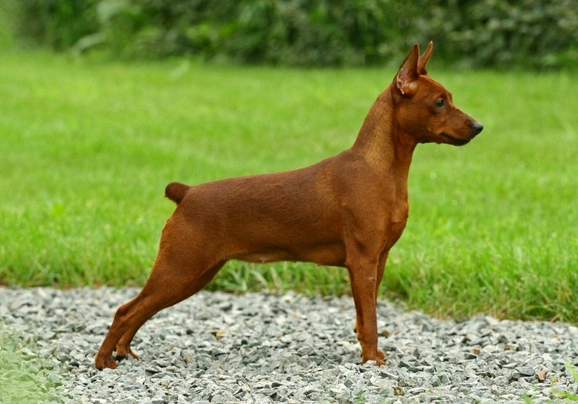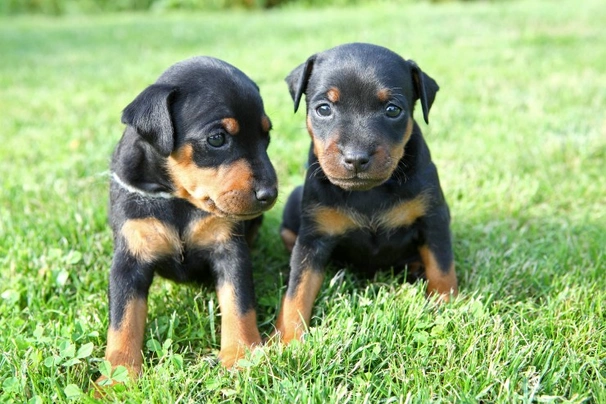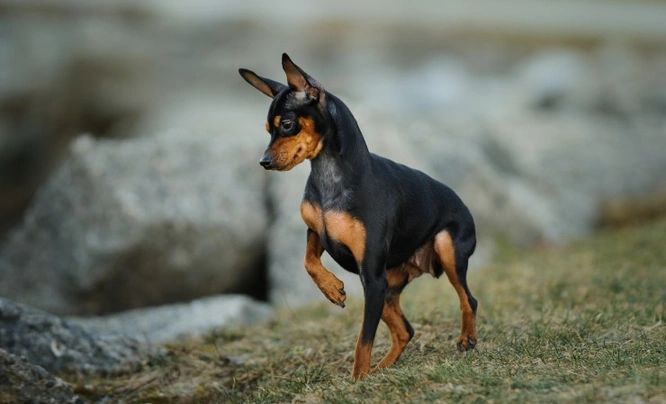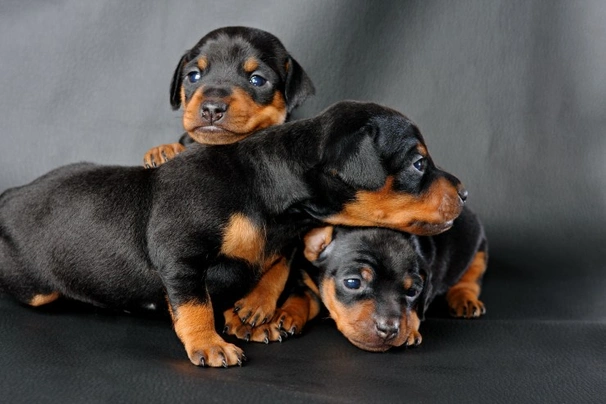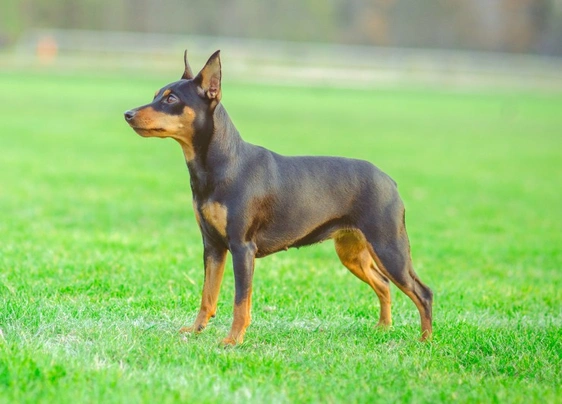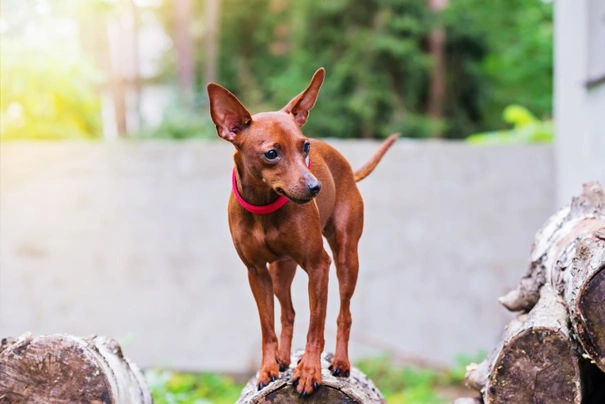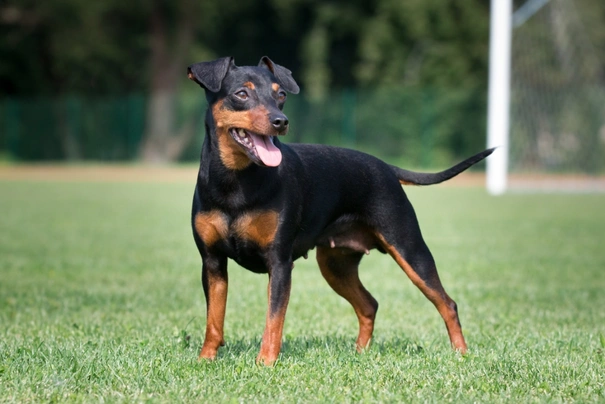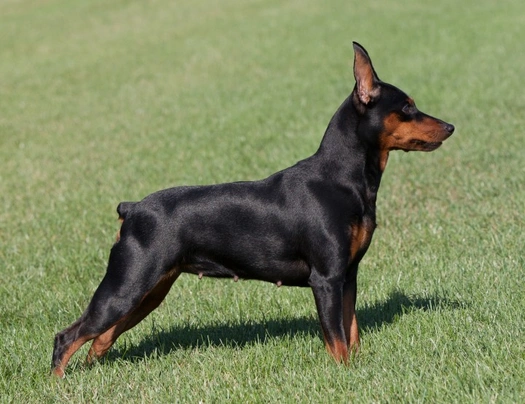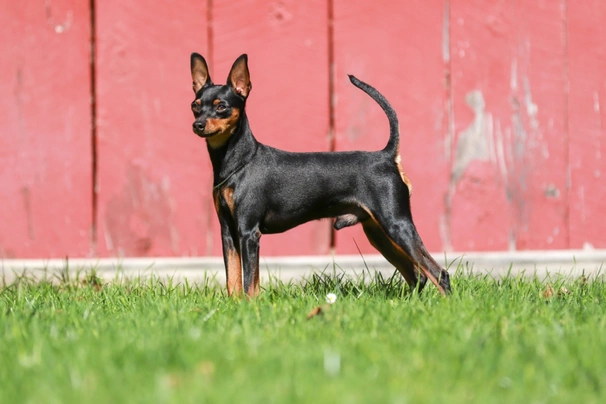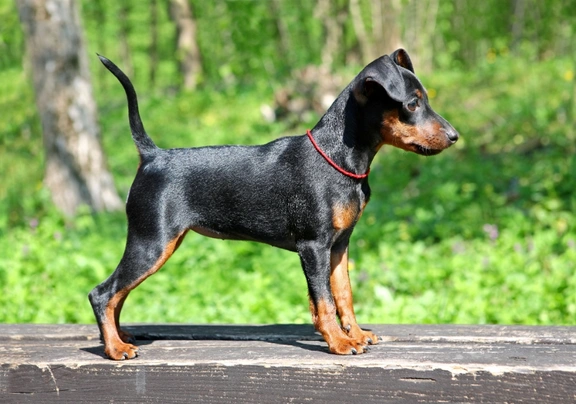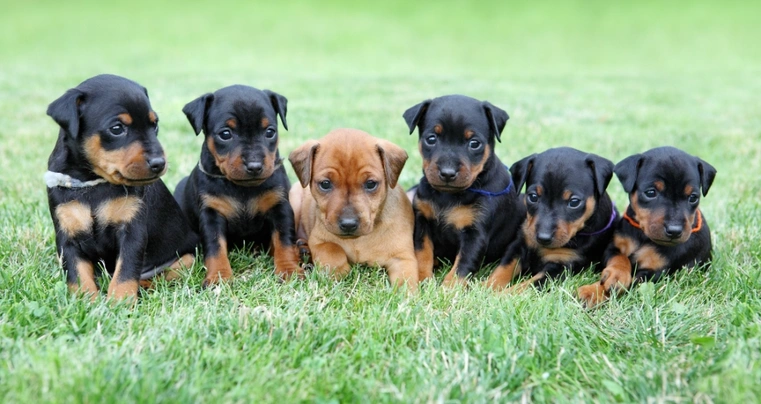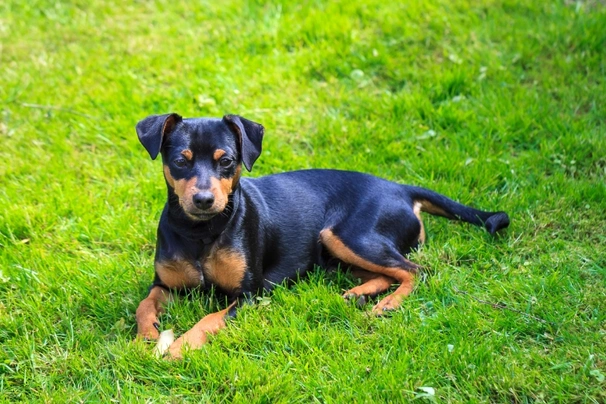Miniature Pinscher
Pros
Cons
Introduction of the Miniature Pinscher
The Miniature Pinscher hails from Germany where they have always been highly prized for their looks their loyalty and they ultra-courageous natures. They have a unique gait which sees these little dogs high-stepping a trait that fits in with their self-assured and confident personalities. Often referred to as Min Pins they are highly curious and inquisitive by nature and like nothing more than to be included in everything that goes on around them which makes them excellent watchdogs.
Miniature Pinschers are intelligent and love to please which means in the right environment and with the correct amount of training they make wonderful companions and family pets although they often prove hard to housetrain which can take time and a lot of patience. They are very well suited to people who lead active outdoor lives and who have well fenced back gardens where a dog can romp and expend all their pent-up energy whenever possible. As such Miniature Pinschers do not adapt well to apartment living.
History of the Miniature Pinscher
Although very similar looking to a Dobermann Pinscher only in miniature the Min Pin is not a descendant or related to these much larger dogs but a breed in its’ own right. They are in fact a much older breed having been around way before the Dobermann. They are thought to have been developed in Germany long ago and that they are descendants of more ancient German Pinscher breeds. Min Pins were originally known as the Reh Pinscher because in their native Germany it was thought these small dogs looked like "roe deer" found in regional forests around the country.
Miniature Pinschers are in fact a smaller variety of dogs known as German Smooth Hair Pinschers that have been around as far back as the 16th Century and they were originally bred to work as "ratters" and there are similar looking dogs depicted in sculptures and works of art that date as far back as the 1600's. It is thought that the name "Pinscher" comes from either of two English words namely "pincer" or "pincher" which described the way a Min Pin catches and kills prey. At one time in 1836 a German writer called Dr. H G Rinchenback claimed that Min Pins were developed by crossing Italian Greyhounds with Dachshunds**.**
Miniature Pinschers remained a popular dog until the turn of the 20th century but during the two World Wars like many other dog populations their numbers fell dangerously low but the breed was thankfully saved from vanishing altogether by enthusiasts. Miniature Pinschers were first recognised by the American Kennel Club in 1925 and classed as “Terriers”. Four years later in 1929 The Miniature Pinscher Club of America was founded. It was not until 1930 that Min Pins were classed as being a Toy breed. The breed was eventually renamed the Miniature Pinscher in 1972.
Over time the Miniature Pinscher has enjoyed somewhat of a resurgence in popularity both here in the UK and elsewhere in the world but more especially in the United States. Today these charming dogs are recognised as a breed by The Kennel Club although very few puppies are registered every year. As such anyone wishing to share their home with a Min Pin would need to register their interest with breeders and agree to being put on a waiting list even though they are among some of the most popular dogs on the Pets4homes website.
Interesting facts about the breed
- Is the Miniature Pinscher a vulnerable breed? No they are among some of the more popular dogs in the UK although anyone wishing to share a home with a Min Pin might need to go on a breeders' waiting list for the pleasure of doing so
- Miniature Pinschers are a much older breed than the Dobermann having been around as far back as the 16th Century
- They were originally known as Reh Pinschers because it was thought they resembled roe deer
- In 1993 a law was passed preventing anyone other than a vet from carrying out the procedure but this was further changed when The Animal Health and Welfare Act (Scotland) came into effect in 2006 which invoked a total ban on tail docking unless for medical reasons. In other parts of the UK the Animal Welfare Act came into effect in April 2007 which meant that dog's tails could no longer be docked unless they fell into the category of a specific "working" dog or for medical reasons providing the correct paperwork has been submitted by a qualified vet who would undertake to carry out the procedure. There is a heavy fine for anyone who has a dog’s tail docked without submitting the necessary paperwork to the right authorities
Appearance of the Miniature Pinscher
Height at the withers: Males 25 - 30 cm Females 25 - 30 cm
Average weight: Males 3.6 - 4.5 kg Females 3.6 - 4.5 kg
The Miniature Pinscher is a compact well-muscled and athletic looking small dog that resembles a small Dobermann although the two breeds are not related at all. They are well-balanced and nicely proportioned having smooth tight close lying coats. Their heads are elongated and narrow being nicely in proportion to the rest of a dog's body. They have long strong muzzles with nicely formed nostrils and black noses although chocolate and blue coated dogs can have lighter coloured noses to match their coats.
Their eyes are black or very dark in colour being neither too round or full and their ears are small being set high on a dog's head which dogs either carry upright or dropped. The Miniature Pinscher has a strong jaw with a perfect scissor bite where their upper teeth neatly overlap their lower ones. Their necks are powerful strong and slightly arched giving the Min Pin their elegant and graceful appearance. They have well developed fore-chests that are moderately broad and their shoulders slope being clean with a moderate amount of angulation. Front legs are straight showing a moderate amount of bone.
The Min Pin has a square compact body with nice straight topline and their bellies are moderately tucked up. Ribs are well sprung and deep. Their back legs are well developed and muscular showing a medium amount of bone. Min Pins have very cat-like feet and strong dark nails. Their tails are set high which dogs carry high adding to their overall well-balanced appearance.
When it comes to their coat the Miniature Pinscher boasts having a smooth hard close lying shiny coat that covers their entire body. The accepted breed colours for Kennel Club registration are as follows:
- Black & Tan
- Blue & Tan
- Chocolate & Tan
- Red
Gait/movement
When a Miniature Pinscher moves they do so with great purpose and have a very distinctly coordinated and true hackneyed gait/action which one of their most distinctive traits.
Faults
The Kennel Club frowns on any exaggerations or departures from the breed standard and would judge the faults on how much they affect a dog's overall health and wellbeing as well as their ability to perform.
Males should have both testicles fully descended into their scrotums and it is worth noting that a dog can be a little lighter or heavier as well as slightly taller or shorter than set out in the Kennel Club breed standard which is given as a guideline only.
Temperament of the Miniature Pinscher
The Miniature Pinscher is a clever albeit strong-willed and often stubborn little dog being described by the Kennel Club in the breed standard as being "fearless and alert". They boast having a ton of energy and true to their "terrier" roots they can be extremely tenacious when it suits them. They are always "ready to go" and Min Pins like to know what is going on around them which means they are excellent watchdogs even though they are so small in stature. They form strong bonds with their owners which once formed remain unbreakable throughout a dog's life.
Because they are so intelligent in the right environment and hands Min Pins learn new things very quickly. The downside being they are just as quick to pick up bad habits and behaviours too. As such their training must start early and it must be consistent throughout a dog's life so they understand what their owners expect of them and their place in the “pack”.
It cannot be stressed strongly enough the importance of early socialisation which must include introducing Min Pins to lots of new situations people noises other animals and dogs once they have been fully vaccinated so they mature into relaxed and easy going little adult dogs. This is especially true as they can be a little aggressive towards other dogs if they have not been well enough socialised when young and will happily take on much larger dogs which often gets them into a trouble.
It they are not given enough daily mental stimulation and exercise a Min Pin would quickly show signs of boredom which could result in them developing all sorts of unwanted and destructive behaviours around the home. They are known to be prolific chewers so if left to their own devices for too long a Min Pin would quickly chew through anything they find which could not only be quite destructive but it could lead to dogs suffering from an intestinal blockage and if not caught early enough it could prove fatal.
Miniature Pinschers need to know their place in the pack and who they can look to for direction and guidance for them to be truly happy well-rounded dogs. If they do not know who is the alpha dog they would quickly take on this role which would make them harder to live with and handle. As previously mentioned their courage and loyalty often gets these small dogs into trouble which is another reason why they need to be well socialised from a young age.
They are also known to like the sound of their own voices which is a behaviour that needs to be gently curbed when dogs are still young before it turns into a real problem. They also love to dig which owners need to bear in mind when they let a dog roam around a back garden. They tend to be suspicious of strangers and will bark when they meet anyone but rarely would a Min Pin show any sort of aggressive behaviour towards anyone they don't know preferring to keep their distance and bark.
Min Pins love to roam around a back garden but the fencing must be ultra-secure to keep these active clever little dogs safely in because they can squeeze through the smallest of gaps when they want to.
Are they a good choice for first time owners?
Miniature Pinschers are not the best choice for first time dog owners even though they are quick to learn and eager to please. The reason being that Min Pins can be wilful and stubborn when the mood takes them which means training a dog can prove challenging. As such it takes a lot of time understanding of the breed and patience to train a Miniature Pinscher and without the right sort of handling a dog might get the better of their owner.
What about prey drive?
Min Pins have a high prey drive and are quick off the mark when it comes to chasing smaller animals and pets when the opportunity arises. They are incredibly tenacious and will not easily give up which is why it's best to keep a Min Pin on the lead when walking them near other dogs wildlife and livestock.
What about playfulness?
Miniature Pinschers have a very playful and mischievous side to their natures and love to entertain the people they love with their silly antics bearing in mind that they are also as previously mentioned highly intelligent and quickly understand what pleases an owner and what they can get away with. Some Min Pins excel at canine sports which includes activities like agility and obedience. They also excel at getting things they want so it’s important that anything harmful is put well out of a Miniature Pinscher’s reach.
What about adaptability?
Although small in stature the Miniature Pinscher is better suited to living with people who have secure back gardens they can roam in whenever possible so they get to really let off steam and where they can really expend all that pent-up energy.
What about separation anxiety?
Min Pins form extremely strong ties with their families and are never very happy when they find themselves on their own for longer periods of time. They are better suited to people who either work from home or in households where one person stays at home when everyone else is out so they are never alone for any length of time which could see a dog suffering from separation anxiety. This can lead to them being destructive around the home which is a dog's way of relieving any stress they are feeling and a way to keep themselves entertained. It is also worth noting that Min Pins are extremely capable of squeezing through the smallest of gaps which includes slightly open windows.
What about excessive barking?
Miniature Pinschers are known to like the sound of their own voices a little too much which is something that needs to be gently nipped in the bud when a dog is still young being careful not to frighten them. However because most of them enjoy barking for the sake of it preventing a Min Pin from barking when the mood takes them can prove challenging.
Do Miniature Pinschers like water?
Most Min Pins like swimming and will take to the water whenever they can more especially when the weather is hot. However if anyone who owns a dog that does not like water should never force them to go in because it would just end up scaring them. With this said care should always be taken when walking a Miniature Pinscher off the lead anywhere near more dangerous watercourses just in case a dog decides to leap in and then needs rescuing because they can't get out of the water without help.
Are Miniature Pinschers good watchdogs?
Miniature Pinschers are natural watchdogs and they are always quick off the mark to let an owner know when there are strangers about although they would rarely do this aggressively preferring to stand their ground and bark. They do not need to be taught to “guard” which could end up making a Min Pin more aggressive towards people and other animals.
Intelligence / Trainability of the Miniature Pinscher
The Miniature Pinscher is an intelligent dog but they are quite strong willed and independent which can make them harder to train and why they are not the best choice for novice owners. They need to be handled and trained by people who are familiar with the needs of this type of active smart dog because otherwise they might just get the better of their handlers. This can result in a Min Pin showing the more dominant and self-assured side of their natures which is something that needs to be gently curbed when dogs are still young and before it turns into a real problem.
The key to successfully training a Min Pin is to start their education as early as possible by teaching a puppy the "basics" as soon as they arrive in their new home. They have to be taught the boundaries which a Min Pin is likely to test throughout their lives just to see how much they can get away with. Training sessions should be short and very interesting because dogs would find it harder to stay focused when things are too repetitive and when training sessions are that much longer.
Like other breeds the Min Pin is known to be a sensitive dog and therefore they do not respond well to any sort of harsh correction or heavier handed training methods. They do answer extremely well to positive reinforcement especially when they know there is a high value food reward when they get things right. Min Pin puppies are incredibly cute and they are smart too which means they can quickly pick up a few bad habits if boundaries and limits are not set for them right from the word go. The first commands a Min Pin puppy must be taught are as follows:
- Come
- Sit
- Stay
- Quiet
- Leave it
- Down
- Bed
Children and other
Miniature Pinschers are generally well behaved around children but they are best suited to families where the kids are slightly older and therefore know how to act around dogs. Any interaction between toddlers and a dog should always be well supervised by an adult to make sure things stay nice and calm because Min Pins can get a bit snappy if playtime gets too noisy and/or boisterous.
They can be a little aggressive around dogs they don't already know which is why early socialisation is so essential for Miniature Pinschers. If they have grown up with a family cat in the home they usually get on well together but a Min Pin would not think twice about chasing off any other cats they come across. Care should always be taken when they are around smaller animals and pets just to be on the safe side because a Min Pin might see them as "fair game".
Health of the Miniature Pinscher
The average life expectancy of a Miniature Pinscher is between 10 and 14 years when properly cared for and fed an appropriate good quality diet to suit their ages.
The Min Pin is known to suffer from a few hereditary health issues which are worth knowing about if you are planning share your home with one of these active and good looking dogs. The conditions that seem to affect the breed the most include the following:
- Patellar luxation - testing available through The Miniature Pinscher Club
- Legg-Calve-Perthes
- Mucopolysaccharidosis
- Diabetes
- Congenital deafness
- Progressive retinal atrophy
- Glaucoma
- Optic nerve hypoplasia
- Alopecia
What about vaccinations?
Miniature Pinscher puppies would have been given their initial vaccinations before being sold but it is up to their new owners to make sure they have their follow-up shots in a timely manner with the vaccination schedule for puppies being as follows:
- 10 -12 weeks old bearing in mind that a puppy would not have full protection straight away but would be fully protected 2 weeks after they have had their second vaccination
There has been a lot of discussion about the need for dogs to have boosters. As such it's best to talk to a vet before making a final decision on whether a dog should continue to have annual vaccinations which are known as boosters.
What about spaying and neutering?
A lot of vets these days recommend waiting until dogs are slightly older before spaying and neutering them which means they are more mature before undergoing the procedures. As such they advise neutering males and spaying females when they are between the ages of 6 to 9 months old and sometimes even when a dog is 12 months old.
Other vets recommend spaying and neutering dogs when they are 6 months old but never any earlier unless for medical reasons. With this said many breeds are different and it is always advisable to discuss things with a vet and then follow their advice on when a dog should be spayed or neutered.
What about obesity problems?
Some Min Pins gain weight after they have been spayed or neutered and it's important to keep an eye on a dog's waistline just in case they do. If a dog starts to put on weight it's important to adjust their daily calorie intake and to up the amount of exercise they are given. Older dogs too are more prone to gaining weight and again it's essential they be fed and exercised accordingly because obesity can shorten a dog's life by several years. The reason being that it puts a lot of extra strain on a dog's internal organs including the heart which could prove fatal.
What about allergies?
Min Pins are prone to suffering from alopecia but they can also develop allergies and it's important for a dog to see a vet sooner rather than later if one flares up. Allergies can be notoriously hard to clear up and finding the triggers can be challenging. With this said a vet would be able to make a dog with an allergy more comfortable while they try to find out the triggers which could include the following:
- Certain foods more especially pet foods that contain high volumes of grain and fillers
- Airborne pollens
- Dust mites
- Environment
- Flea and tick bites
- Chemicals found in everyday household cleaning products
Participating in health schemes
All responsible Miniature Pinscher breeders would ensure that their stud dogs are tested for known hereditary and congenital health issues known to affect the breed by using the following schemes:
- Patella (Kneecap) Testing Scheme - offered by the Miniature Pinscher Club with the optimum age of a dog being between 12 and 24 months old
What about breed specific breeding restrictions?
Apart from the standard breeding restrictions for all Kennel Club registered breeds there are no other breed specific breeding restrictions in place for the Miniature Pinscher.
What about Assured Breeder Requirements?
Currently there are no Kennel Club Assured Breeder requirements in place for the Miniature Pinscher but all breeders should have stud dogs tested for patellar luxation.
More about tail docking
In 1993 a law was passed preventing anyone other than a vet from carrying out the procedure but this was further changed when The Animal Health and Welfare Act (Scotland) came into effect in 2006 which invoked a total ban on tail docking unless for medical reasons. In other parts of the UK the Animal Welfare Act came into effect in April 2007 which meant that dog's tails could no longer be docked unless they fell into the category of a specific "working" dog or for medical reasons providing the correct paperwork has been submitted by a qualified vet who would undertake to carry out the procedure. There is a heavy fine for anyone who has a dog’s tail docked without submitting the necessary paperwork to the right authorities.
Caring for the Miniature Pinscher
As with any other breed Min Pins need to be groomed on a regular basis to make sure their coats and skin are kept in top condition bearing in mind that Min Pins are sometimes prone to suffering from alopecia. They also need to be given regular daily exercise to ensure they remain fit and healthy. On top of this dogs need to be fed good quality food that meets all their nutritional needs throughout their lives.
Caring for a Miniature Pinscher puppy
Miniature Pinscher puppies are boisterous and full of life which means it's essential for homes and gardens to be puppy-proofed well in advance of their arrival. A responsible breeder would have well socialised their puppies which always leads to more outgoing confident and friendly dogs right from the word go. With this said any puppy is going to feel vulnerable when they leave their mother and littermates which must be taken into account. The longer a puppy can remain with their mother the better although it should never be for too long either.
It's best to pick a puppy up when people are going to be around for the first week or so which is the time needed for a puppy to settle in. Puppy-proofing the home and garden means putting away any tools and other implements that a boisterous puppy might injure themselves on. Electric wires and cables must be put out of their reach because puppies love chewing on things. Toxic plants should be removed from flowerbeds and the home too.
Puppies need to sleep a lot to grow and develop as they should which means setting up a quiet area that's not too out of the way means they can retreat to it when they want to nap and it's important not to disturb them when they are sleeping. It's also a good idea to keep "playtime" nice and calm inside the house and to have a more active "playtime" outside in the garden which means puppies quickly learn to be less boisterous when they are inside.
The documentation a breeder provides for a puppy must have all the details of their worming date and the product used as well as the information relating to their microchip. It is essential for puppies to be wormed again keeping to a schedule which is as follows:
- Puppies should be wormed at 6 months old
- They need to be wormed again when they are 8 months old
- Puppies should be wormed when they are 10 months old
- They need to be wormed when they are 12 months old
Things you'll need for your puppy
There are certain items that new owners need to already have in the home prior to bringing a new puppy home. It's often a good idea to restrict how much space a puppy plays in more especially when you can't keep an eye on what they get up to bearing in mind that puppies are often quite boisterous which means investing in puppy gates or a large enough playpen that allows a Min Pin puppy the room to express themselves while keeping them safe too. The items needed are therefore as follows:
- Good quality puppy or baby gates to fit on doors
- A good well-made playpen that's large enough for a puppy to play in so they can really express themselves as puppies like to do
- Lots of well-made toys which must include good quality chews suitable for puppies to gnaw on bearing in mind that a puppy will start teething anything from when they are 3 to 8 months old
- Good quality feed and water bowls which ideally should be ceramic rather than plastic or metal
- A grooming glove
- A slicker brush or soft bristle brush
- Dog specific toothpaste and a toothbrush
- Scissors with rounded ends
- Nail clippers
- Puppy shampoo and conditioner which must be specifically formulated for use on dogs
- A well-made dog collar or harness
- A couple of strong dog leads
- A well-made dog bed that's not too small or too big
- A well-made dog crate for use in the car and in the home that's large enough for a puppy to move around in
- Baby blankets to put in your puppy's crate and in their beds for when they want to nap or go to sleep at night
Keeping the noise down
All puppies are sensitive to noise including Min Pin puppies. It's important to keep the noise levels down when a new puppy arrives in the home. TVs and music should not be played too loud which could end up stressing a small puppy out.
Keeping vet appointments
As previously mentioned Miniature Pinscher puppies would have been given their first vaccinations by the breeders but they must have their follow up shots which is up to their new owners to organise. The vaccination schedule for puppies is as follows:
- 10 -12 weeks old bearing in mind that a puppy would not have full protection straight away but would only be fully protected 2 weeks after they have had their second vaccination
When it comes to boosters it's best to discuss these with a vet because there is a lot of debate about whether a dog really needs them after a certain time. However if a dog ever needed to go into kennels their vaccinations would need to be
What about older Miniature Pinscher when they reach their senior years?
Older Min Pins need lots of special care because as they reach their golden years they are more at risk of developing certain health concerns. Physically a dog's muzzle may start to go grey but there will be other noticeable changes too which includes the following:
- Coats become coarser
- A loss of muscle tone
- Min Pins can either become overweight or underweight
- They have reduced strength and stamina
- Older dogs have difficulty regulating their body temperature
- They often develop arthritis
- Immune systems do not work as efficiently as they once did which means dogs are more susceptible to infections
Older dogs change mentally too which means their response time tends to be slower as such they develop the following:
- They respond less to external stimuli due to impaired vision or hearing
- They tend to be a little pickier about their food
- They have a lower pain threshold
- Become intolerant of any change
- Often an older dog can feel disorientated
Living with a Miniature Pinscher in their golden years means taking on a few more responsibilities but these are easily managed and should include taking a look at their diet the amount of exercise they are given how often their dog beds need changing and keeping an eye on the condition of their teeth.
Older Min Pins need to be fed a good quality diet that meets their needs at this stage of their lives all the while keeping a close eye on a dog's weight. A rough feeding guide for older dogs is as follows bearing in mind they should be fed highly digestible food that does not contain any additives:
- Protein content should be anything from 14 – 21%
- Fat content should be less than 10%
- Fibre content should be less than 4%
- Calcium content should be 0.5 – 0.8%
- Phosphorous content should be 0.4 – 0.7%
- Sodium content should be 0.2 – 0.4%
Older Min Pins don't need to be given the same amount of daily exercise as a younger dog but they still need the right amount of physical activity to maintain muscle tone and to prevent a dog from putting on too much weight. All dogs need access to fresh clean water and this is especially true of older dogs when they reach their golden years because they are more at risk of developing kidney disorders.
Grooming of the Miniature Pinscher
Miniature Pinschers are low maintenance on the grooming front thanks to their smooth short and close lying coats. A once or twice weekly brush is all it takes to keep their coats looking good and to remove any loose and shed hair. They shed steadily throughout the year only more so during the Spring and then again in the Autumn when more frequent brushing is usually necessary to stay on top of things. A weekly wipe over with a chamois leather would keep their coats nice and shiny too.
It's also important to check a dog's ears on a regular basis and to clean them when necessary. If too much wax builds up in a dog's ears it can lead to a painful infection which can be hard to clear up. In short prevention is often easier than cure when it comes to ear infections.
Exercise of the Miniature Pinscher
The Miniature Pinscher is an energetic intelligent dog and as such they need to be given the right amount of daily exercise and mental stimulation for them to be truly happy well-rounded dogs. They need anything from 20 to 30 minutes exercise a day with as much off the lead time as possible. If they are not given the right amount of mental stimulation and exercise every day a Min Pin would quickly get bored and could even begin to show some destructive behaviours around the home which is their way of relieving the stress they may be feeling.
A shorter walk in the morning would be fine but a longer more interesting one in the afternoon is a must. These dogs also like to be able to roam around a back garden as often as possible so they can really let off steam. However the fencing must be extremely secure to keep these active dogs in because if they find a weakness in the fence they will soon escape out and get into all sorts of trouble bearing in mind there is nothing a Min Pin enjoys more than digging and they are excellent climbers too.
With this said puppies should not be over exercised because their joints and bones are still growing. This includes not letting a dog jump up and down from furniture or going up or down the stairs. Too much pressure placed on their joints and spines at an early age could result in a dog developing serious problems later in their lives.
Feeding of the Miniature Pinscher
If you get a Min Pin puppy from a breeder they would give you a feeding schedule and it's important to stick to the same routine feeding the same puppy food to avoid any tummy upsets. You can change a puppy's diet but this needs to be done very gradually always making sure they don't develop any digestive upsets and if they do it's best to put them back on their original diet and to discuss things with the vet before attempting to change it again.
Older dogs are not known to be fussy eaters but this does not mean they can be fed a lower quality diet. It's best to feed a mature dog twice a day once in the morning and then again in the evening making sure it's good quality food that meets all their nutritional requirements. It's also important that dogs be given the right amount of exercise so they burn off any excess calories or they might gain too much weight which can lead to all sorts of health issues. Obesity can shorten a dog's life by several years so it's important to keep an eye on their waistline from the word go.
Feeding guide for a Miniature Pinscher puppy
Puppies need to be fed a highly nutritious good quality diet for them to develop and grow as they should. As a rough guide a Miniature Pinscher puppy can be fed the following amounts every day making sure their meals are evenly spread out throughout the day and it's best to feed them 3 or 4 times a day:
- 2 months old - 68g to 92g depending on puppy's build
- 3 months old - 74g to 108g depending on puppy's build
- 4 months old - 75g to 114g depending on puppy's build
- 5 months old - 75g to 115g depending on puppy's build
- 6 months old - 67g to 114g depending on puppy's build
- 7 months old - 60g to 92g depending on puppy's build
- 8 months old - 59g to 90g depending on puppy's build
- 9 months old - 59g to 89g depending on puppy's build
- 10 months old - 59g to 88g depending on puppy's build
Once a puppy is 11 months old they can be fed adult dog food.
Feeding guide for an adult Miniature Pinscher
Once fully mature an adult Miniature Pinscher must be fed a good quality diet to ensure their continued good health. As a rough guide an adult Min Pin can be fed the following amounts every day:
- Dogs weighing 3.6 kg can be fed 65g to 73g depending on activity
- Dogs weighing 4 kg can be fed 68g to 79g depending on activity
- Dogs weighing 4.5 kg can be fed 75g to 88g depending on activity
Miniature Pinscher price
If you are looking to buy a Miniature Pinscher you would need to pay anything from £300 to over £700 for a well-bred pedigree puppy. The cost of insuring a male 3-year-old Miniature Pinscher in northern England would be £19.44 a month for basic cover but for a lifetime policy this would set you back £41.75 a month (quote as of July 2016). When insurance companies calculate a pet's premium they factor in several things which includes where you live in the UK a dog's age and whether they have been neutered or spayed among other things.
When it comes to food costs you need to buy the best quality food whether wet or dry making sure it suits the different stages of a dog’s life. This would set you back between £20 - £30 a month. On top of this you need to factor in veterinary costs if you want to share your home with a Min Pin and this includes their initial vaccinations their annual boosters the cost of neutering or spaying a dog when the time is right and their yearly health checks all of which quickly adds up to over £800 a year.
As a rough guide the average cost to keep and care for a Miniature Pinscher would be between £50 to £80 a month depending on the level of insurance cover you opt to buy for your dog but this does not include the initial cost of buying a well-bred healthy Kennel Club registered pedigree Miniature Pinscher puppy.
Buying advice
When visiting and buying any puppy or dog there are many important things to consider and questions to ask of the breeder/seller. You can read our generic puppy/dog advice here which includes making sure you see the puppy with its mother and to verify that the dog has been wormed and microchipped.
Miniature Pinschers are a very popular breed both in the UK and elsewhere in the world which means that well-bred puppies command a lot of money. As such with Miniature Pinschers there is specific advice questions and protocols to follow when buying a puppy which are as follows:
- Beware of online scams and how to avoid them. You may see online and other adverts by scammers showing images of beautiful Miniature Pinscherpuppies for sale at very low prices. However the sellers ask buyers for money up front before agreeing to deliver a puppy to a new home. Potential buyers should never buy a puppy unseen and should never pay a deposit or any other money online to a seller. You should always visit the pet at the sellers home to confirm they are genuine and make a note of their address.
- As previously touched upon Min Pins are among one of the more popular breeds in the UK. As such there are many amateur breeders/people who breed from Min Pin dam far too often so they can make a quick profit without caring for the welfare of the puppies their dam or the breed in general. Under Kennel Club rules a dam can only produce 4 litters and she must be between a certain age to do so. Anyone wishing to buy a Min Pin puppy should think very carefully about who they purchase their puppy from and should always ask to see the relevant paperwork pertaining to a puppy's lineage their vaccinations and their microchipping
- Prospective Miniature Pinscher owners should be very careful when considering buying an extra small puppy because all too often they suffer from very serious health issues and no responsible breeder would purposefully breed dogs so they are too small
- In 1993 a law was passed preventing anyone other than a vet from carrying out the procedure but this was further changed when The Animal Health and Welfare Act (Scotland) came into effect in 2006 which invoked a total ban on tail docking unless for medical reasons. In other parts of the UK the Animal Welfare Act came into effect in April 2007 which meant that dog's tails could no longer be docked unless they fell into the category of a specific "working" dog or for medical reasons providing the correct paperwork has been submitted by a qualified vet who would undertake to carry out the procedure. There is a heavy fine for anyone who has a dog’s tail docked without submitting the necessary paperwork to the right authorities

Miniature Pincher Puppies
£1,500
Stunning tiny tea cup miniature pinscher puppy
£1,250

